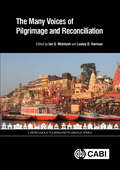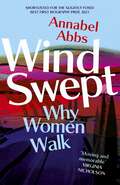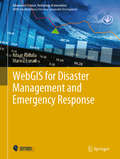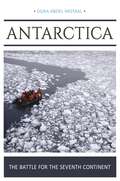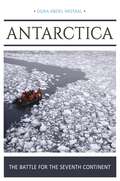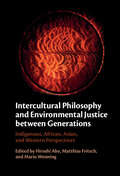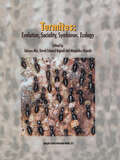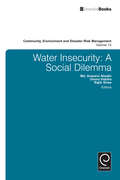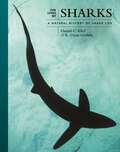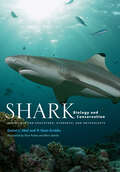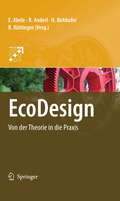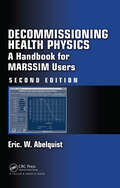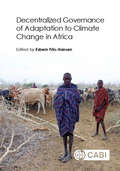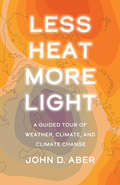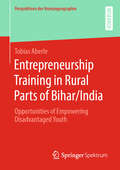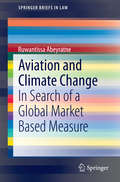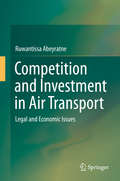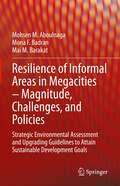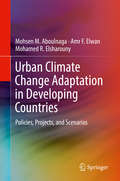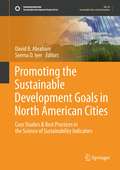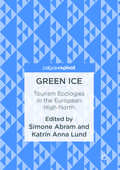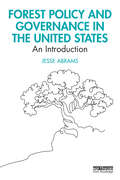- Table View
- List View
Many Voices of Pilgrimage and Reconciliation, The (CABI Religious Tourism and Pilgrimage Series)
by Tahar Abbou Lucinda Carspecken John Hornblow Jenny Boyack Sonika Jain Nanna Natalia Jørgensen Steven Muir Zülfükar Özdogan Cindy Pavlinac E. Moore Quinn Mari-Johanna Rahkala-Simberg Varada Sambus Patricia A. Sayre Daniel J. Simons Chadwick Co Su Sara TerreaultReviewing peace and reconciliation, secular pilgrimages, and international perspectives on sacred journeys, this book offers the reader an opportunity to encounter multiple voices and viewpoints on one of the most ancient practices of humankind. With an estimated third of all international travellers now undertaking journeys anticipating an aspect of transformation (the hallmark of pilgrimage), this book includes both spiritual and non-spiritual voyages, such as journeys of self-therapy, mindfulness and personal growth. It also: - Provides a multidisciplinary perspective, covering themes such as gender, human rights, equality, the environment, peace, history, literature, and politics - Reflects the rich diversity and multiple meanings of pilgrimage through an international writer team spanning four continents - Includes case studies of pilgrimage in action from around the world An innovative and engaging addition to the pilgrimage literature, this book provides an important resource for researchers of religious tourism and related subjects.
Windswept: walking in the footsteps of remarkable women
by Annabel Abbs'A triumph ... I felt as though I were being lifted, carried up to peaks.' - Charlotte Peacock, author of. Into the Mountain: A Life of Nan Shepherd 'I couldn't put it down. Quite extraordinary... written in such a free flowing, readable style. I'm in awe.' - Maggie Humm, author of Talland HouseThe story of extraordinary women who lost their way - their sense of self, their identity, their freedom - and found it again through walking in the wild. A feminist exploration of the power of walking in nature, following in the footsteps of Gwen John, Georgia O'Keeffe, Frieda Lawrence, Clara Vyvyan, Simone de Beauvoir, Daphne Du Maurier and Nan Shepherd. For centuries, the wilds have been male territory, while women sat safely confined at home. But not all women did as they were told, despite the dangers; history is littered with women for whom rural walking became inspiration, consolation and liberation. In this powerful and deeply inspiring book, Annabel Abbs uncovers women who refused to conform, who recognised a biological, emotional and artistic need for wilderness, water and desert - and who took the courageous step of walking unpeopled and often forbidding landscapes. Part wild-walk, part memoir, Windswept follows an exhilarating journey from Abbs' isolated car-less childhood to her walking the remote paths trodden by extraordinary women including Georgia O'Keeffe in the empty plains of Texas and New Mexico, Nan Shepherd in the mountains of Scotland, Gwen John following the Garonne, Simone de Beauvoir in the mountains and forests of France and Daphne du Maurier following the River Rhone. A single question pulses through their walks: How does a woman change once she becomes windswept?
WebGIS for Disaster Management and Emergency Response (Advances in Science, Technology & Innovation)
by Rifaat Abdalla Marwa EsmailThis book aims to help students, researchers and policy makers understand the latest research and development trends in the application of WebGIS for Disaster Management and Emergency Response. It is designed as a useful tool to better assess the mechanisms for planning, response and mitigation of the impact of disaster scenarios at the local, regional or national levels. It contains details on how to use WebGIS to solve real-world problems associated with Disaster Management Scenarios for the long-term sustainability. The book broadens the reader understanding of the policy and decision-making issues related to Disaster Management response and planning.
Petroleum Economics and Engineering
by Hussein K. Abdel-Aal Mohammed A. AlsahlawiThis book explains how to apply economic analysis to the evaluation of engineering challenges in the petroleum industry. Discussion progresses from an introduction to the industry, through principles and techniques of engineering economics, to the application of economic methods. Packed with real-world examples and case studies demonstrating how to
Antarctica: The Battle for the Seventh Continent
by Doaa Abdel-MotaalThe thawing Antarctic continent offers living space and marine and mineral resources that were previously inaccessible. This book discusses how revisiting the Antarctic Treaty System and dividing up the continent preemptively could spare the world serious conflict.The Antarctic Treaty and related agreements—collectively known as the Antarctic Treaty System (ATS)—regulate the seventh continent, which is the only continent without a native human population. The main treaty within the ATS came into force in 1961 and suspended all territorial claims in Antarctica. The Antarctic Environmental Protocol followed in 1998 and prohibited any minerals exploitation in the continent. With this prohibition up for review in 2048, this book asks whether the Antarctic Treaty can continue to protect Antarctica. Doaa Abdel-Motaal—an expert on environmental issues who has traveled through the Arctic and Antarctic—explains that the international community must urgently turn its attention to examining how to divide up the thawing continent in a peaceful manner. She discusses why the Antarctic Treaty is unlikely to be an adequate measure in the face of international competition for invaluable resources in the 21st century. She argues that factors such as global warming, the growth in climate refugees that the world is about to witness, and the increasingly critical quest for energy resources will make the Antarctic continent a highly sought-after objective.Readers will come to appreciate that what has likely protected Antarctica so far was not the Antarctic Treaty but the continent's harsh climate and isolation. With Antarctica potentially becoming habitable only a few decades from now, revisiting the Antarctic Treaty in favor of an orderly division of the continent is likely to be the best plan for avoiding costly conflict.
Antarctica: The Battle for the Seventh Continent
by Doaa Abdel-MotaalThe thawing Antarctic continent offers living space and marine and mineral resources that were previously inaccessible. This book discusses how revisiting the Antarctic Treaty System and dividing up the continent preemptively could spare the world serious conflict.The Antarctic Treaty and related agreements—collectively known as the Antarctic Treaty System (ATS)—regulate the seventh continent, which is the only continent without a native human population. The main treaty within the ATS came into force in 1961 and suspended all territorial claims in Antarctica. The Antarctic Environmental Protocol followed in 1998 and prohibited any minerals exploitation in the continent. With this prohibition up for review in 2048, this book asks whether the Antarctic Treaty can continue to protect Antarctica. Doaa Abdel-Motaal—an expert on environmental issues who has traveled through the Arctic and Antarctic—explains that the international community must urgently turn its attention to examining how to divide up the thawing continent in a peaceful manner. She discusses why the Antarctic Treaty is unlikely to be an adequate measure in the face of international competition for invaluable resources in the 21st century. She argues that factors such as global warming, the growth in climate refugees that the world is about to witness, and the increasingly critical quest for energy resources will make the Antarctic continent a highly sought-after objective.Readers will come to appreciate that what has likely protected Antarctica so far was not the Antarctic Treaty but the continent's harsh climate and isolation. With Antarctica potentially becoming habitable only a few decades from now, revisiting the Antarctic Treaty in favor of an orderly division of the continent is likely to be the best plan for avoiding costly conflict.
All Walls Collapse: Stories of Separation
by Muyesser Abdul’ehed Zahra El Hasnaoui Ahmed Maya Abu Al-Hayat Larissa Boehning Rezuwan Khan Paulo Scott Kyung-Sook Shin Geetanjali Shree Constantia Soteriou Krisztina Tóth Juan Pablo VillalobosThe history of walls – as a way to keep people in or out – is also the history of people managing to get around, over and under them. From the Berlin Wall and the Mexico–US border, to the barbed wire fences of Bangladesh’s refugee camps, the short stories in this anthology explore the barriers that have sought to divide communities and nations, and their traumatic effects on people’s lives and histories. At a time when more walls are being built than are being brought down, All Walls Collapse brings together writing from across national, ethnic and linguistic borders, challenging the political impulse to separate and segregate, and celebrating the role of literature in traversing division.
Intercultural Philosophy and Environmental Justice between Generations: Indigenous, African, Asian, and Western Perspectives
by Hiroshi Abe Matthias Fritsch Mario WenningThis anthology combines an intercultural approach with intergenerational ethics to address critical environmental challenges. Written by scholars from all over the world, including Canada, the US, New Zealand, Nigeria, Ethiopia, Japan, the UK, China, and Spain, this book offers new perspectives on how to foster sustainable societal practises that draw on the past and are fair to future generations. It introduces the Māori idea that views all things and human generations in layered relations; Indigenous accounts of spiralling time and reciprocities among ancestors and descendants; the philosophical dimensions of Chinese conceptions of ancestor spirits and future ghosts; and African accounts of anamnestic solidarity among generations. These ideas influence proposals for how to confront ending worlds and address the environmental future of humanity, making this book a valuable resource for scholars and students of environmental law and policy, environmental humanities, political science, and intercultural and comparative philosophy, as well as policymakers.
'Cherry' Ingram: The Englishman Who Saved Japan’s Blossoms
by Naoko AbeThe irresistible story of Japanese cherry blossoms, threatened by political ideology and saved by an unknown EnglishmanCollingwood Ingram, known as ‘Cherry’ for his defining obsession, was born in 1880 and lived until he was a hundred, witnessing a fraught century of conflict and change. After visiting Japan in 1902 and 1907 and discovering two magnificent cherry trees in the garden of his family home in Kent in 1919, Ingram fell in love with cherry blossoms, or sakura, and dedicated much of his life to their cultivation and preservation.On a 1926 trip to Japan to search for new specimens, Ingram was shocked to see the loss of local cherry diversity, driven by modernisation, neglect and a dangerous and creeping ideology. A cloned cherry, the Somei-yoshino, was taking over the landscape and becoming the symbol of Japan's expansionist ambitions.The most striking absence from the Japanese cherry scene, for Ingram, was that of Taihaku, a brilliant ‘great white’ cherry tree. A proud example of this tree grew in his English garden and he swore to return it to its native home. Multiple attempts to send Taihaku scions back to Japan ended in failure, but Ingram persisted.Over decades, Ingram became one of the world’s leading cherry experts and shared the joy of sakura both nationally and internationally. Every spring we enjoy his legacy. ‘Cherry’ Ingram is a portrait of this little-known Englishman, a story of Britain and Japan in the twentieth century and an exploration of the delicate blossoms whose beauty is admired around the world.
Termites: Evolution, Sociality, Symbioses, Ecology
by Y. Abe David Edward Bignell T. HigashiThe book is a new compendium in which leading termite scientists review the advances of the last 30 years in our understanding of phylogeny, fossil records, relationships with cockroaches, social evolution, nesting, behaviour, mutualisms with archaea, protists, bacteria and fungi, nutrition, energy metabolism,population and community ecology, soil conditioning, greenhouse gas production and pest status.
Water Insecurity: A Social Dilemma (Community, Environment and Disaster Risk Management #13)
by M. A. Abedin Umma Habiba Rajib ShawIt has been estimated that globally, 1.2 billion people live with acute shortage of water. Water scarcity, particularly in south and south-east Asian countries, is well known. However, the social dilemmas and insecurities related to water issues are often less discussed. In the case of south and south-east Asia, the distribution of available water amongst various casts and creeds has been determined through several social hierarchies. Hence, water forms a critical socio-political issue, with a multi-faced dimension. This book critically analyses the associated social issues of increasing water scarcity in countries such as India. It documents the social impacts and predicament of water scarcity. The book will be of prime interest to researchers, policy makers and practitioners in the fields of development and environment, as well as water planners, and it will be a useful reference guide for future research in the field of water scarcity and risk management. Topics analysed include arsenic contamination, the impact of salinity on livelihood and mitigation, and drought resilience, adaptation and policy. The book concludes by providing lessons, challenges and future perspectives of water insecurity.
The Lives of Sharks: A Natural History of Shark Life (The Lives of the Natural World #7)
by Daniel C. Abel Dr. R. Dean GrubbsA richly illustrated and comprehensive introduction to the world’s sharksSharks are the top predators in many marine ecosystems. But tales of the killer instincts and fearsomely sharp senses of these hunters can obscure their full life histories. In fact, sharks are characterful, exhibit surprisingly complex behaviors, and lead secretive lives full of interest in every type of marine habitat. The Lives of Sharks is a fascinating and beautifully illustrated guide to these iconic marine creatures from two world-renowned experts. This book explores shark physiology, anatomy, behavior, ecology, and evolution, as well as conservation and the impact of human activity on shark populations. With stunning photographs and illustrations, as well as profiles of selected species, this is a comprehensive, authoritative, and inviting introduction to global shark life today.
Shark Biology and Conservation: Essentials for Educators, Students, and Enthusiasts
by Daniel C. Abel R. Dean GrubbsStudies of shark biology have flourished over the last several decades. An explosion of new research methods is leading to a fascinating era of oceanic discovery. Shark Biology and Conservation is an up-to-date, comprehensive overview of the diversity, evolution, ecology, behavior, physiology, anatomy, and conservation of sharks. Written in a style that is detailed but not intimidating by world-renowned shark specialists Dan Abel and Dean Grubbs, it relays numerous stories and insights from their exciting experiences in the field. While explaining scientific concepts in terms that non-specialists and students can understand, Abel and Grubbs reveal secrets that will illuminate even the experts. The text provides readers with a robust and wide range of essential knowledge as it• introduces emerging as well as traditional techniques for classifying sharks, understanding their behavior, and unraveling the mysteries of their evolution;• draws on both established shark science and the latest breakthroughs in the field, from molecular approaches to tracking technologies;• highlights the often-neglected yet fascinating subject of shark physiology, including heart function, sensory biology, digestion, metabolic performance, and reproduction;• addresses big picture ecological questions like "Which habitats do sharks prefer?" and "Where do sharks migrate and for what purpose?";• describes the astonishing diversity of sharks' adaptations to their environment;• discusses which shark conservation techniques do and don't work; and• comments on the use and misuse of science in the study of sharks.Enhanced by hundreds of original color photographs and beautifully detailed line drawings, Shark Biology and Conservation will appeal to anyone who is spellbound by this wondrous, ecologically important, and threatened group, including marine biologists, wildlife educators, students, and shark enthusiasts.
EcoDesign: Von der Theorie in die Praxis
by Eberhard Abele Reiner Anderl Herbert Birkhofer Bruno RüttingerDie TU Darmstadt setzte in Kooperation mit namhaften Industrieunternehmen EcoDesign nachhaltig in deren Unternehmenspraxis um. Der Forschungsbereich wurde von der DFG gefördert und erzielte praxisnahe und nachvollziehbare Ergebnisse: zukünftige rechtliche Rahmenbedingungen, Implementierung, Entwicklung umweltgerechter Energiespeicher, Arbeitsmittel für Investitionsgüter u.v.m. Plus: konkrete Fallbeispiele, Umsetzungsleitfaden für Anwender.
Decommissioning Health Physics: A Handbook for MARSSIM Users, Second Edition
by Eric W. AbelquistExperienced Guidance on the Technical Issues of Decommissioning ProjectsWritten by one of the original MARSSIM authors, Decommissioning Health Physics: A Handbook for MARSSIM Users, Second Edition is the only book to incorporate all of the requisite technical aspects of planning and executing radiological surveys in support of decommissioning. Exte
Decentralized Governance of Adaptation to Climate Change in Africa
by Charles Aben Professor Jacob Agea Bernard Bashaasha Sarah Ann D'Haen Esbern Friis-Hansen Mikkel Funder Carol Mweemba Isaac Nakendo Jonas Østergaard Nielsen Professor Imasiku Nyambe James Okiror Julie Fogt Rasmussen Godfrey SuubiTwo perspectives have dominated the social science discourse on climate change adaptation. Firstly, an international narrative among UN and donor agencies of technical and financial support for planned climate change adaptation. Secondly, a significant volume of studies discuss how local communities can undertake their own autonomous adaptation. Effective and sustainable climate adaptation requires a third focus: understanding of the political processes within sub-national institutions that mediate between national and local practices. This book address the knowledge gap that currently exists about the role of district-level institutions in Sub-Saharan Africa in providing an enabling institutional environment for rural climate change adaptation. Key Features: · Analyses the disconnect between national and local policy and practice, and how to overcome it · Analysis of the political ecology of climate change adaptation in 10 diverse rural districts across Sub-Saharan Africa based on evidence from thorough field work · Explains how to improve the efficiency and effectiveness of climate change adaptation programmes by engaging with decentralized local governments and principles of subsidiarity with regards to decision-making and control over financial resources
Less Heat, More Light: A Guided Tour of Weather, Climate, and Climate Change
by John D. AberA straightforward and fact-based exploration of how weather happens, how it relates to climate, and how science answers major questions about Earth as a system Climate change is one of the most hotly contested environmental topics of our day. To answer criticisms and synthesize available information, scientists have been driven to devise increasingly complex models of the climate system. This book conveys that the basics of climate and climate change have been known for decades, and that relatively simple descriptions can capture the major features of the climate system and help the general public understand what controls climate and weather, and how both might be changing. Renowned environmental scientist and educator John D. Aber distills what he has learned from a long fascination with weather and climate, the process of science, and the telling of the story of science. This is not a book about policies and politics. Instead, it explores how weather happens, how it relates to climate, and how science has been used to answer major questions about the Earth as a system and inform policies that have reversed environmental degradation. By providing a guided tour of the science of weather, this thoughtful survey will contribute clarity and rationality to the public understanding of climate change.
Entrepreneurship Training in Rural Parts of Bihar/India: Opportunities of Empowering Disadvantaged Youth (Perspektiven der Humangeographie)
by Tobias AberleTobias Aberle examines how an entrepreneurship training helps disadvantaged youths in rural parts of Bihar, India, to cope with structural conditions that enable or constrain them. The present research reveals that young entrepreneurs can be divided into two groups: those who developed personal initiative and thus coped with limiting structural conditions very proactively, and those who solely behaved in a reactive way. For many entrepreneurs, the self-employed activity was only a Plan B, as in reality they sought for high-prestige career jobs. IFor entrepreneurship training to become a tool of empowerment, the range of training must be significantly adjusted in accordance with young trainees’ social and educational backgrounds. In addition, a functioning ecosystem for entrepreneurship education must be in place, which ensures support for individual entrepreneurs through mentorship and networks.
Aviation and Climate Change: In Search of a Global Market Based Measure (SpringerBriefs in Law)
by Ruwantissa AbeyratneThe book addresses the most critical issue faced by aviation and climate change: namely the development of a market based measure to control aircraft engine emissions. It discusses the current market economic trends as they impact to aviation and suggests steps and measures to be taken in the development of a workable MBM. ICAO has three years to come up with such an MBM on a global scale and this book will spur discussions on how to achieve this objective.
Competition and Investment in Air Transport: Legal and Economic Issues
by Ruwantissa AbeyratneThis book addresses emerging legal and economic issues in competition and investment in air transport, against the backdrop of the role governments and airlines should play in avoiding protectionism and encouraging innovation and creativity. It evaluates current trends in air transport and the direction the industry is taking in the twenty first century. There are discussions on key aspects of air transport, such as safety assurance and environmental protection, as they are impacted by competition. The rapid evolution of aerospace transport and its effect on competition in air transport is also examined. A recurring theme of the book is the influence of creative destruction and disruptive innovation on air transport. This is addressed through an in-depth study of the contentious areas of law relating to the abuse of dominant positions and state aid, as reflected in the ongoing claim by the three largest US carriers against Gulf carriers such as Emirates Airlines, Etihad and Qatar Airways. The US carriers claim that Emirates and Etihad – which operate air services into the United States by virtue of an open-skies agreement between the US and The United Arab Emirates - are using generous subsidies given to them by their governments to illegally capture the “legitimate” market belonging to the US carriers. These issues are clarified in the book using analyses of competition law and investment law as they apply to air transport, free-trade-agreement analogies and an open-skies case study.
Resilience of Informal Areas in Megacities – Magnitude, Challenges, and Policies: Strategic Environmental Assessment and Upgrading Guidelines to Attain Sustainable Development Goals
by Mohsen M. Aboulnaga Mona F. Badran Mai M. BarakatThis book focuses on the socio-economic and sustainability challenges facing megacities in dealing with the dramatic population increases of informal areas and settlements (or slums), especially when coupled with the impacts and risks of climate change. The authors examine informal urban areas globally and in developing countries utilizing strategic environmental assessment (SEA) as a tool to solve the sequence of upgrading steps concerning slums and shanty towns, and also establish essential guidelines for local governments and stakeholders to create a balance and quality of life for slums dwellers, particularly in the age of the COVID-19 pandemic, through applying sustainability indicators that enhance the upgrading process. Coverage includes recent statistics and mapping of informal areas worldwide and assessment of the GIZ and Sir Norman Foster models in terms of energy demands and consequential emission of CO2 and air pollution from slums. Three models of Maspero’s Triangle are also studied and assessed. The book is essential reading for a wide range of researchers, students, policymakers, governments, and professionals as well as a good source for research centers and academicians working in energy, climate change, urban environments, and sustainable urban development.
Urban Climate Change Adaptation in Developing Countries: Policies, Projects, and Scenarios
by Mohsen M. Aboulnaga Amr F. Elwan Mohamed R. ElsharounyThis book describes the risks, impacts, measures, actions and adaptation policies that have developed globally as a result of the severe impacts of global climate change. In-depth chapters focus on climate change assessment (CCA) in terms of vulnerabilities and reflection on the built environment and measures and actions for infrastructure and urban areas. Adaptation actions specific to developing countries such as Egypt are presented and illustrated. Global Climate change adaptation projects (CCAPs) in developing countries, in terms of their targets and performance, are presented and compared with those existing CCAPs in Egypt to draw learned lessons. Climate change scenarios 2080 using simulations are portrayed and discussed with emphasis on a case-study model from existing social housing projects in hot-arid urban areas in Cairo; in an effort to put forward an assessment and evaluation of current CCA techniques. This book helps researchers realize the global impacts of climate change on the built environment and economic sectors, and enhances their understanding of current climate change measures, actions, policies, projects and scenarios.Reviews and illustrates the impact of global climate change risks;Provides an understanding of global climate change risks in seven continents;Illustrates policies and action plans implemented at the global level and developing countries' level;Discusses climate change assessment and vulnerabilities with emphasis on urban areas;Presents measures and action plans to mitigate climate change scenarios by 2080.
Promoting the Sustainable Development Goals in North American Cities: Case Studies & Best Practices in the Science of Sustainability Indicators (Sustainable Development Goals Series)
by David B. Abraham Seema D. IyerThis volume presents North American best practices and perspectives on developing, managing and monitoring indicators to track development progress towards the Sustainable Development Goals (SDGs) in local communities and cities. In 4 main sections, the book presents and frames the many ways in which community indicator programs are either integrating or retooling to integrate the SDGs into their existing frameworks, or how they are developing new programs to track and report progress on the SDGs. This is the first volume that focuses on SDG adoption within the context of North Americans cities and communities, and the unique issues and opportunities prevalent in these settings. The chapters are developed by experienced academics and practitioners of community planning and sustainable development, and will add broad perspective on public policy, organizational management, information management and data visualization. This volume presents a case-study approach to chapters, offering lessons that can be used by three main audiences: 1) teachers and researchers in areas of urban, regional, and environmental planning, urban development, and public policy; 2) professional planners, decision-makers, and urban managers; and 3) sustainability activists and interested groups.
Green Ice: Tourism Ecologies in the European High North
by Simone Abram Katrín Anna LundThis book presents lively case studies of tourism developments in the European High North from diverse perspectives. It compares views of the changing political ecology of a fragile region shaped by climatic and cultural factors. In exploring the mutual relations between new developments in Arctic travel narratives and tourism practices. Green Ice: Tourism Ecologies in the European High North pays particular attention to the changing discourses that produce, and are in turn produced by, encounters between contemporary Arctic peoples and territories. Questions of gender and nationality are considered alongside a comparison of texts and practices in different languages, examining the politics of language and its significant role in tourism. This title pays attention to the changing symbolic value of Arctic discourses in environmental movements, in order to consider the close connections between global forms of environmentalist discourse and action and local cultural responses. An engaging and timely work, this book will be of great interest to scholars of Geography, Anthropology, and Arctic Tourism.
Forest Policy and Governance in the United States: An Introduction
by Jesse AbramsThis new textbook provides an up-to-date and comprehensive introduction to both the policy background and contemporary governance of forests in the United States. Starting with a history of the development of forest policies and conservation agencies, the book then explores the diversity of forest owners, users, and uses and examines emerging approaches to forest governance that cross traditional jurisdictional and property boundaries. It tackles key contemporary issues such as the forest water nexus, the conservation of threatened and endangered species, and the challenges of managing fire, insect, and disease dynamics under a changing climate. Key focal areas include the emergence of collaborative approaches to forest governance, community forest relationships, changes to corporate timberland ownership, and contemporary governance mechanisms such as certification and payments for ecosystem services. This text raises the "big questions" about the distribution of rights and responsibilities in forest management, the tensions between equity and efficiency, and how to sustain a diversity of forest values under the pressures of ecological and social complexity. Written in an accessible and engaging manner, this textbook provides a timely synthesis of both the foundations and current trends and issues in forest policy and governance in the United States with a strong emphasis on illustrative real-world cases. Forest Policy and Governance in the United States is essential reading for students in forest and natural resource policy courses and will be of great use to students in environmental governance courses. It will also be of interest to policymakers and professionals working in forest conservation and in the forest industry.
